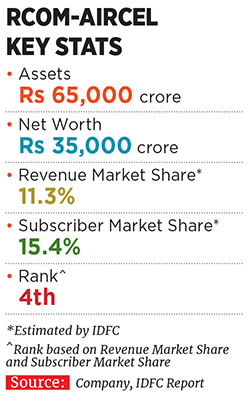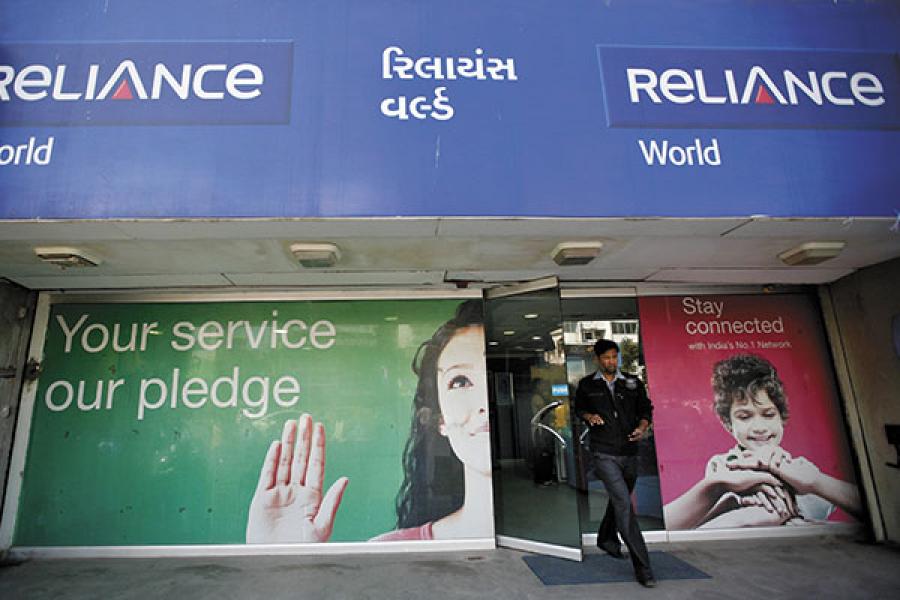
The math behind the RCom-Aircel merger
New entity will have benefits of scale, but existing debt can hinder required investments
Consolidation has been imminent in the Indian telecom sector for the last few years, and the first steps have been taken by Reliance Communications Ltd (RCom), the Rs 22,000 crore-telecom services company of the Anil Ambani-led Reliance Group.
This March, RCom shareholders approved plans to merge the wireless telecom services operations of Sistema Shyam Teleservices Ltd with the company in an all-stock deal valued at Rs 4,500 crore. Then, on September 14, RCom and Aircel Ltd, another Indian telco owned by Malaysia’s Maxis Communications Berhad, said they were hiving off their respective wireless businesses into a separate, new entity, as an equal joint venture between the two companies.
The merger will create India’s fourth largest telco in terms of subscriber base and revenue market share (RMS), with the second-largest spectrum portfolio, assets worth Rs 65,000 crore and a net worth of Rs 35,000 crore.
A September 14 IDFC Securities report says the new entity will have an RMS of 11.3 percent and subscriber market share of 15.4 percent; it is expected to have an Ebitda (earnings before interest, tax, depreciation and amortisation) between Rs 4,600 crore and Rs 6,000 crore. “The combined entity will enjoy substantial benefits of scale driving significant revenue growth, and capex and opex synergies with a net present value of around Rs 20,000 crore,” an RCom statement said.
The other ostensible motive behind the move was to reduce debt, a chronic challenge for RCom. As on June 30, RCom had a net debt of Rs 42,071 crore; in FY16, its net debt-to-Ebitda ratio stood at 5.5 times.
 According to the plan, RCom and Aircel will each transfer Rs 14,000 crore of debt to the new company in addition to a liability of Rs 7,000 crore of deferred spectrum payments obligation, making the new telco’s immediate net debt Rs 35,000 crore. RCom said the transaction will help it reduce its debt by Rs 20,000 crore. But half of the new entity’s debt should still show up on RCom’s consolidated balance sheet by virtue of its 50 percent stake in it.
According to the plan, RCom and Aircel will each transfer Rs 14,000 crore of debt to the new company in addition to a liability of Rs 7,000 crore of deferred spectrum payments obligation, making the new telco’s immediate net debt Rs 35,000 crore. RCom said the transaction will help it reduce its debt by Rs 20,000 crore. But half of the new entity’s debt should still show up on RCom’s consolidated balance sheet by virtue of its 50 percent stake in it.If the new entity has to efficiently compete with incumbents, and new entrants like Reliance Jio—controlled by Mukesh Ambani’s Reliance Industries Ltd, it has announced free voice calls and rock-bottom data prices on its 4G network; it has also deposited Rs 6,500 crore in earnest money with the department of telecom for an upcoming spectrum auction—it will have to invest substantially to upgrade its infrastructure and expand operations. And a leveraged balance sheet may not give it the financial leeway to do so.
These concerns reflect in RCom’s stock performance since it announced the deal. Between September 14 and 19, its share price fell 4.3 percent on the BSE, while the bourse’s benchmark index gained 0.92 percent.
(Disclaimer: Reliance Industries is the owner of Network 18, publisher of Forbes India)
(This story appears in the 14 October, 2016 issue of Forbes India. To visit our Archives, click here.)















